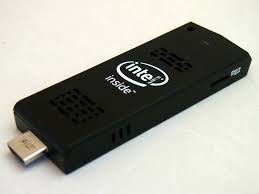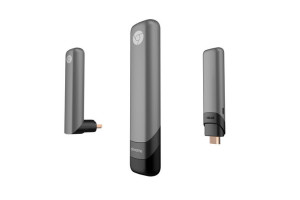I love flash drives. I collect them, actually. We have at least one of each gigabyte size currently available at casa de Hartlaub, and in a couple of different shapes as well. Late at night, when the rest of the house is asleep, I tiptoe downstairs and play 24, pretending I’m Jack Bauer, moving documents and photos and music, oh my, from one computer to another and back again and doing it quickly, because, y’ know, “we’re running out of time!” Yes, I love flash drives, particularly the ones that come in shapes. If technology stopped right now with flash drives, I’d be happy.
Technology of course isn’t stopping. I just this morning learned of something — a couple of something’s, really — that made a shiver run up (or maybe down) my leg. You will be able in less than a month to buy something called an “Intel Compute Stick.”
It is a computer which is just a bit larger than a flash drive. Yes, I said a computer: not just a hard drive, but a computer. It will have an HDMI connector so that you can connect it to your television monitor (or that older computer monitor that you keep in the spare bedroom where you stash your brother-in-law when he turns up, unannounced) and a Bluetooth connection for a keyboard. The Stick will come in Windows and Ubuntu versions and will run between $100 and $150, and watch for that price range to drop quickly. That’s not the end however:
Asus is coming out with something called the Chromebit this summer (which will — can you guess? — run Chrome). it is also a computer and it will be had for under $100.00 as well. A comparison between the two computer-on-a-stick models can be had in an excellent article by Jamie Lendino running on ExtremeTech and which you can find here.
I’m going to go way out on the limb of the tallest tree of the forest and predict that these little innovations — computers that you can carry on your keychain — will change everything again. There will need to be a couple of innovations in the fields of monitors and keyboards (maybe those virtual tabletop models that keep popping up in the James Bond movies and, uh, 24) but this innovation put a computer in the hand — literally — of every school kid in the country for one-sixth the cost of an iPhone. And what does it mean for me and you? More portability. More access. More productivity. Things that are beyond my imagination. It reminds me of the images that graced the cover and gatefold of the Led Zeppelin album Presence, which was created by a graphic design group named Hipgnosis. Those guys knew what was coming, back in the 1970s. They just didn’t think small enough:
Check all of this out, if you are so inclined. What do you think? Can you use this? If so, how? Or do you think it will be a dud, for you and for everyone?



